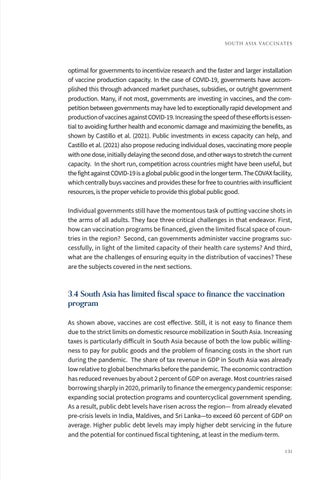S o u t h A s i a Va c c i n a t e s
optimal for governments to incentivize research and the faster and larger installation of vaccine production capacity. In the case of COVID-19, governments have accomplished this through advanced market purchases, subsidies, or outright government production. Many, if not most, governments are investing in vaccines, and the competition between governments may have led to exceptionally rapid development and production of vaccines against COVID-19. Increasing the speed of these efforts is essential to avoiding further health and economic damage and maximizing the benefits, as shown by Castillo et al. (2021). Public investments in excess capacity can help, and Castillo et al. (2021) also propose reducing individual doses, vaccinating more people with one dose, initially delaying the second dose, and other ways to stretch the current capacity. In the short run, competition across countries might have been useful, but the fight against COVID-19 is a global public good in the longer term. The COVAX facility, which centrally buys vaccines and provides these for free to countries with insufficient resources, is the proper vehicle to provide this global public good. Individual governments still have the momentous task of putting vaccine shots in the arms of all adults. They face three critical challenges in that endeavor. First, how can vaccination programs be financed, given the limited fiscal space of countries in the region? Second, can governments administer vaccine programs successfully, in light of the limited capacity of their health care systems? And third, what are the challenges of ensuring equity in the distribution of vaccines? These are the subjects covered in the next sections.
3.4 South Asia has limited fiscal space to finance the vaccination program As shown above, vaccines are cost effective. Still, it is not easy to finance them due to the strict limits on domestic resource mobilization in South Asia. Increasing taxes is particularly difficult in South Asia because of both the low public willingness to pay for public goods and the problem of financing costs in the short run during the pandemic. The share of tax revenue in GDP in South Asia was already low relative to global benchmarks before the pandemic. The economic contraction has reduced revenues by about 2 percent of GDP on average. Most countries raised borrowing sharply in 2020, primarily to finance the emergency pandemic response: expanding social protection programs and countercyclical government spending. As a result, public debt levels have risen across the region— from already elevated pre-crisis levels in India, Maldives, and Sri Lanka—to exceed 60 percent of GDP on average. Higher public debt levels may imply higher debt servicing in the future and the potential for continued fiscal tightening, at least in the medium-term. 131




